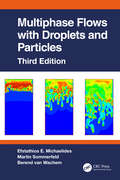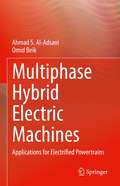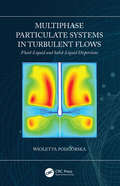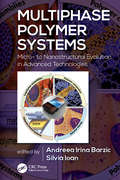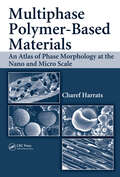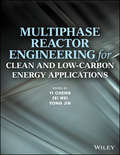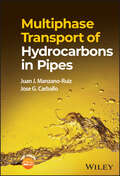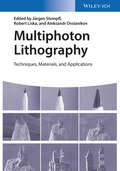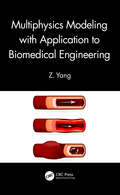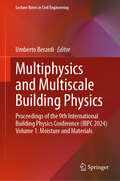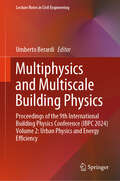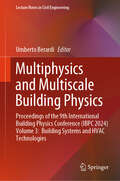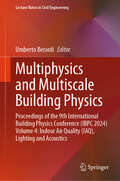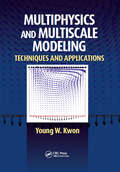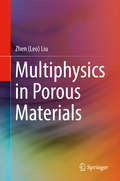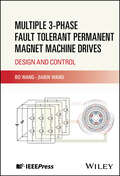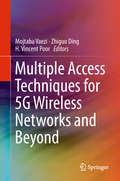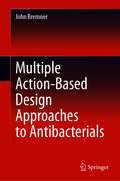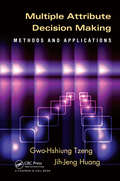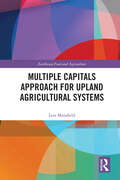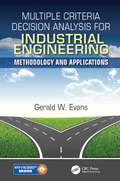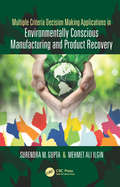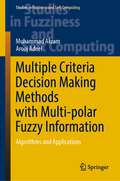- Table View
- List View
Multiphase Flows with Droplets and Particles, Third Edition
by Efstathios E. Michaelides Martin Sommerfeld Berend van WachemMultiphase Flows with Droplets and Particles provides an organized, pedagogical study of multiphase flows with particles and droplets. This revised edition presents new information on particle interactions, particle collisions, thermophoresis and Brownian movement, computational techniques and codes, and the treatment of irregularly shaped particles. An entire chapter is devoted to the flow of nanoparticles and applications of nanofluids. Features Discusses the modelling and analysis of nanoparticles. Covers all fundamental aspects of particle and droplet flows. Includes heat and mass transfer processes. Features new and updated sections throughout the text. Includes chapter exercises and a Solutions Manual for adopting instructors. Designed to complement a graduate course in multiphase flows, the book can also serve as a supplement in short courses for engineers or as a stand-alone reference for engineers and scientists who work in this area.
Multiphase Hybrid Electric Machines: Applications for Electrified Powertrains
by Omid Beik Ahmad S. Al-AdsaniThis book provides an insight into the design, modeling, control, and application of multiphase hybrid permanent magnet machines for electrified powertrains in electric and hybrid electric vehicles. The authors present an overview of electric and hybrid electric vehicles, hybrid electric machine topologies, hybrid permanent magnet (HPM) machine design, multiphase hybrid machines, operation of multiphase generators in series hybrid electric vehicles (SHEV), and machine hardware build-up and testing. Readers will gain an understanding of multiphase machine configuration, their design, control, and recent applications, along with the benefits they provide, and learn general design steps, prototyping, and hardware build-up processes of multiphase electric machines. Multiphase Hybrid Electric Machines: Applications for Electrified Powertrains will be a valuable reference for undergraduate and graduate students, researchers, and practicing engineers, working on electric/hybrid electric vehicles, as well as electric machine applications in renewable energy systems specifically wind turbines, HVAC systems, robotics, and aerospace industry.
Multiphase Particulate Systems in Turbulent Flows: Fluid-Liquid and Solid-Liquid Dispersions
by Wioletta PodgórskaMultiphase Particulate Systems in Turbulent Flows: Fluid-Liquid and Solid-Liquid Dispersions provides methods necessary to analyze complex particulate systems and related phenomena including physical, chemical and mathematical description of fundamental processes influencing crystal size and shape, suspension rheology, interfacial area of drops and bubbles in extractors and bubble columns. Examples of mathematical model formulation for different processes taking place in such systems is shown. Discussing connections between turbulent mixing mechanisms and precipitation, it discusses influence of fine-scale structure of turbulence, including its intermittent character, on breakage of drops, bubbles, cells, plant cell aggregates. An important aspect of the mathematical modeling presented in the book is multi-fractal, taking into account the influence of internal intermittency on different phenomena. Key Features Provides detailed descriptions of dispersion processes in turbulent flow, interactions between dispersed entities, and continuous phase in a single volume Includes simulation models and validation experiments for liquid-liquid, gas-liquid, and solid-liquid dispersions in turbulent flows Helps reader learn formulation of mathematical models of breakage or aggregation processes using multifractal theory Explains how to solve different forms of population balance equations Presents a combination of theoretical and engineering approaches to particulate systems along with discussion of related diversity, with exercises and case studies
Multiphase Polymer Systems: Micro- to Nanostructural Evolution in Advanced Technologies
by Andreea Irina Barzic and Silvia IoanPhase morphology in multicomponent polymer-based systems represents the main physical characteristic that allows for control of the material design and implicitly the development of new plastics. Emphasizing properties of these promising new materials in both solution and solid phase, this book describes the preparation, processing, properties, and practical implications of advanced multiphase systems from macro to nanoscales. It covers a wide range of systems including copolymers, polymer blends, polymer composites, gels, interpenetrating polymers, and layered polymer/metal structures, describing aspects of polymer science, engineering, and technology. The book analyzes experimental and theoretical aspects regarding the thermal and electrical transport phenomena and magnetic properties of crucial importance in advanced technologies. It reviews the most recent advances concerning morphological, rheological, interfacial, physical, fire-resistant, thermophysical, and biomedical properties of multiphase polymer systems. Concomitantly the book deals with basic investigation techniques that are sensitive in elucidating the features of each phase. It also discusses the latest research trends that offer new solutions for advanced bio- and nanotechnologies. Introduces an overview of recent studies in the area of multiphase polymer systems, their micro- and nanostructural evolutions in advanced technologies, and provides future outlooks, new challenges and opportunities. Discusses multicomponent structures that offer enhanced physical, mechanical, thermal, electrical, magnetic, and optical properties adapted to current requirements of modern technologies. Covers a wide range of materials, such as composites, blends, alloys, gels and interpenetrating polymer networks. Presents new strategies for controlling the micro- and nanomorphology and the mechanical properties of multiphase polymeric materials. Describes different applications of multiphase polymeric materials in various fields, including automotive, aeronautics and space industry, displays, and medicine.
Multiphase Polymer- Based Materials: An Atlas of Phase Morphology at the Nano and Micro Scale
by Charef HarratsDuring the past 10 years a large variety of new multiphase polymer-based materials have been studied from a morphological point of view. Simultaneously, huge progress has been achieved in microscopy. These circumstances underline the need for a reference that delineates the differences of various types of nanostructures in multiphase polymer-based
Multiphase Reactor Engineering for Clean and Low-Carbon Energy Applications
by Fei Wei Yi Cheng Yong JinProvides a comprehensive review on the brand-new development of several multiphase reactor techniques applied in energy-related processes Explains the fundamentals of multiphase reactors as well as the sophisticated applications Helps the reader to understand the key problems and solutions of clean coal conversion techniques Details the emerging processes for novel refining technology, clean coal conversion techniques, low-cost hydrogen productions and CO2 capture and storage Introduces current energy-related processes and links the basic principles of emerging processes to the features of multiphase reactors providing an overview of energy conversion in combination with multiphase reactor engineering Includes case studies of novel reactors to illustrate the special features of these reactors
Multiphase Transport of Hydrocarbons in Pipes
by Juan J. Manzano-Ruiz Jose G. CarballoMultiphase Transport of Hydrocarbons in Pipes An introduction to multiphase flows in the oil and gas industry The term ‘multiphase flow’ refers to the concurrent flow of oil and/or gas, alongside other substances or materials such as production water, chemical inhibitors, and solids (e.g. sand). This is a critical topic in the oil and gas industry, where the presence of multiple flow phases in pipelines affects deliverability, generates serious complications in predicting flow performance for system design and operation, and requires specific risk mitigation actions and continuous maintenance. Chemical and Mechanical Engineers interested in working in this industry will benefit from understanding the basic theories and practices required to model and operate multiphase flows through pipelines, wells, and other components of the production system. Multiphase Transport of Hydrocarbons in Pipes meets this need with a comprehensive overview of five decades of research into multiphase flow. Incorporating fundamental theories, historic and cutting-edge multiphase flow models, and concrete examples of current and future applications. This book provides a sound technical background for prospective or working engineers in need of understanding this crucial area of industry. Readers will also find: Fundamental principles supporting commercial software Detailed tools for estimating multiphase flow rates through flowlines, wells, and more Integration of conservation principles with thermodynamic and transport properties Coverage of legacy and modern simulation models This book is ideal for flow assurance engineers, facilities engineers, oil and gas production engineers, and process engineers, as well as chemical and mechanical engineering students looking to work in any of these roles.
Multiphoton Lithography: Techniques, Materials, and Applications
by Jürgen Stampfl Aleksandr Ovsianikov Robert LiskaThis first book on this fascinating, interdisciplinary topic meets the much-felt need for an up-to-date overview of the field. Written with both beginners and professionals in mind, this ready reference begins with an introductory section explaining the basics of the various multi-photon and photochemical processes together with a description of the equipment needed. A team of leading international experts provides the latest research results on such materials as new photoinitiators, hybrid photopolymers, and metallic carbon nanotube composites. They also cover promising applications and prospective trends, including photonic crystals, microfluidic devices, biological scaffolds, metamaterials, waveguides, and functionalized hydrogels. By bringing together the essentials for both industrial and academic researchers, this is an invaluable companion for materials scientists, polymer chemists, surface chemists, surface physicists, biophysicists, and medical scientists working with 3D micro- and nanostructures.
Multiphoton Processes and Attosecond Physics
by Kaoru Yamanouchi Midorikawa KatsumiRecent advances in ultrashort pulsed laser technology have opened new frontiers in atomic, molecular and optical sciences. The 12th International Conference on Multiphoton Processes (ICOMP12) and the 3rd International Conference on Attosecond Physics (ATTO3), held jointly in Sapporo, Japan, during July 3-8, showcased studies at the forefront of research on multiphoton processes and attosecond physics. This book summarizes presentations and discussions from these two conferences.
Multiphysics Modeling with Application to Biomedical Engineering
by Z. YangThe aim of this book is to introduce the simulation of various physical fields and their applications for biomedical engineering, which will provide a base for researchers in the biomedical field to conduct further investigation. The entire book is classified into three levels. It starts with the first level, which presents the single physical fields including structural analysis, fluid simulation, thermal analysis, and acoustic modeling. Then, the second level consists of various couplings between two physical fields covering structural thermal coupling, porous media, fluid structural interaction (FSI), and acoustic FSI. The third level focuses on multi-coupling that coupling with more than two physical fields in the model. Each part in all levels is organized as the physical feature, finite element implementation, modeling procedure in ANSYS, and the specific applications for biomedical engineering like the FSI study of Abdominal Aortic Aneurysm (AAA), acoustic wave transmission in the ear, and heat generation of the breast tumor. The book should help for the researchers and graduate students conduct numerical simulation of various biomedical coupling problems. It should also provide all readers with a better understanding of various couplings.
Multiphysics and Multiscale Building Physics: Proceedings of the 9th International Building Physics Conference (IBPC 2024) Volume 1: Moisture and Materials (Lecture Notes in Civil Engineering #552)
by Umberto BerardiThis book contains selected papers presented at the 9th edition of the official triennial conference of the International Association of Building Physics (IABP), held in Toronto, Ontario, Canada on 25-27 July, 2024. The contents make valuable contributions to academic researchers and practioners of the building sector. Readers will encounter new ideas for realizing more efficient and resilient buildings and cities. The approach followed in the book aims to explore how building physics can be explored using multi domains and scales.
Multiphysics and Multiscale Building Physics: Proceedings of the 9th International Building Physics Conference (IBPC 2024) Volume 2: Urban Physics and Energy Efficiency (Lecture Notes in Civil Engineering #553)
by Umberto BerardiThis book contains selected papers presented at the 9th edition of the official triennial conference of the International Association of Building Physics (IABP), held in Toronto, Ontario, Canada on 25-27 July, 2024. The contents make valuable contributions to academic researchers and practioners of the building sector. Readers will encounter new ideas for realizing more efficient and resilient buildings and cities. The approach followed in the book aims to explore how building physics can be explored using multi domains and scales.
Multiphysics and Multiscale Building Physics: Proceedings of the 9th International Building Physics Conference (IBPC 2024) Volume 3: Building Systems and HVAC Technologies (Lecture Notes in Civil Engineering #554)
by Umberto BerardiThis book contains selected papers presented at the 9th edition of the official triennial conference of the International Association of Building Physics (IABP), held in Toronto, Ontario, Canada on 25-27 July, 2024. The contents make valuable contributions to academic researchers and practioners of the building sector. Readers will encounter new ideas for realizing more efficient and resilient buildings and cities. The approach followed in the book aims to explore how building physics can be explored using multi domains and scales.
Multiphysics and Multiscale Building Physics: Proceedings of the 9th International Building Physics Conference (IBPC 2024) Volume 4: Indoor Air Quality (IAQ), Lighting and Acoustics (Lecture Notes in Civil Engineering #555)
by Umberto BerardiThis book contains selected papers presented at the 9th edition of the official triennial conference of the International Association of Building Physics (IABP), held in Toronto, Ontario, Canada on 25-27 July, 2024. The contents make valuable contributions to academic researchers and practioners of the building sector. Readers will encounter new ideas for realizing more efficient and resilient buildings and cities. The approach followed in the book aims to explore how building physics can be explored using multi domains and scales.
Multiphysics and Multiscale Modeling: Techniques and Applications
by Young W. KwonWritten to appeal to a wide field of engineers and scientists who work on multiscale and multiphysics analysis, Multiphysics and Multiscale Modeling: Techniques and Applications is dedicated to the many computational techniques and methods used to develop man-made systems as well as understand living systems that exist in nature. Presenting a body
Multiphysics in Porous Materials
by Zhen Leo LiuThis book summarizes, defines, and contextualizes multiphysics with an emphasis on porous materials. It covers various essential aspects of multiphysics, from history, definition, and scope to mathematical theories, physical mechanisms, and numerical implementations. The emphasis on porous materials maximizes readers’ understanding as these substances are abundant in nature and a common breeding ground of multiphysical phenomena, especially complicated multiphysics. Dr. Liu’s lucid and easy-to-follow presentation serve as a blueprint on the use of multiphysics as a leading edge technique for computer modeling. The contents are organized to facilitate the transition from familiar, monolithic physics such as heat transfer and pore water movement to state-of-the-art applications involving multiphysics, including poroelasticity, thermohydro-mechanical processes, electrokinetics, electromagnetics, fluid dynamics, fluid structure interaction, and electromagnetomechanics. This volume serves as both a general reference and specific treatise for various scientific and engineering disciplines involving multiphysics simulation and porous materials.
Multiple 3-phase Fault Tolerant Permanent Magnet Machine Drives: Design and Control
by Bo Wang Jiabin WangGroundbreaking analysis of a fully functional fault-tolerant machine drive Electrical machine drives have become an increasingly important component of transportation electrification, including electric vehicles, railway and subway traction, aerospace actuation, and more. This expansion of electrical machine drives into safety-critical areas has driven an increasingly urgent demand for high reliability and strong fault tolerance. Machine drives incorporating a permanent magnet (PM)-assisted synchronous reluctance machine drive with a segregated winding have shown to exhibit notably reduced PM flux and correspondingly enhanced fault tolerance. Multiple 3-Phase Fault Tolerant Permanent Magnet Machine Drives: Design and Control offers one of the first fully integrated accounts of a functional fault-tolerant machine drive. It proposes a segregated winding which can be incorporated into multiple machine topologies without affecting performance and brings together cutting-edge technologies to manage these crucial drives in both healthy and fault conditions. The result is a must-own for engineers and researchers alike. Readers will also find: Advanced modeling techniques for different operation conditions Detailed discussion on topics including fault detection techniques, postfault tolerant control strategies, and many more An authorial team with immense experience in the study of fault-tolerant machine drives Multiple 3-Phase Fault Tolerant Permanent Magnet Machine Drives: Design and Control is ideal for researchers and graduate students in engineering and related industries.
Multiple Access Techniques for 5G Wireless Networks and Beyond
by H. Vincent Poor Mojtaba Vaezi Zhiguo DingThis book presents comprehensive coverage of current and emerging multiple access, random access, and waveform design techniques for 5G wireless networks and beyond. A definitive reference for researchers in these fields, the book describes recent research from academia, industry, and standardization bodies. The book is an all-encompassing treatment of these areas addressing orthogonal multiple access and waveform design, non-orthogonal multiple access (NOMA) via power, code, and other domains, and orthogonal, non-orthogonal, and grant-free random access. The book builds its foundations on state of the art research papers, measurements, and experimental results from a variety of sources.
Multiple Access Technology Towards Ubiquitous Networks: Overview and Efficient Designs
by Xiangming Li Kai Yang Jianping An Neng YeThis book investigates the multiuser communication and its key technology—multiple access technology, as well as transceiving design methods. Multiple access methods toward B5G and 6G currently allows the superposition transmissions of multiuser signals with controllable mutual interference. By deploying advanced multiuser detector, current technology significantly enhances the connectivity, improves the spectral efficiency and simplifies the signaling interactions. Considering that the major challenge of current multiple access technology is the design of transceiver due to the overlapped and distorted signals from multiple users, we analyze the promising candidate multiple access schemes and then develop some sights on how to formulate the transmit signals and how to achieve efficient symbol recovery. Specifically, the incorporation of constellation rotation, rate splitting and deep learning techniques in enhancing the transmission efficiency of multiple access technology are considered.
Multiple Action-Based Design Approaches to Antibacterials
by John BremnerThis book covers intentional design aspects for combinations of drugs, single-molecule hybrids with potential or actual multiple actions, pro-drugs which could yield multiple activity outcomes, and future possibilities. The approach of the book is interdisciplinary, and it provides greater understanding of the complex interplay of factors involved in the medicinal chemistry design and laboratory development of multiply active antibacterials. The scope of the book appeals to readers who are researching in the field of antibacterials using the approach of medicinal chemistry design and drug development.
Multiple Attribute Decision Making: Methods and Applications
by Gwo-Hshiung Tzeng Jih-Jeng HuangDecision makers are often faced with several conflicting alternatives. How do they evaluate trade-offs when there are more than three criteria? To help people make optimal decisions, scholars in the discipline of multiple criteria decision making (MCDM) continue to develop new methods for structuring preferences and determining the correct relative
Multiple Capitals Approach for Upland Agricultural Systems (Earthscan Food and Agriculture)
by Lois MansfieldThis book focuses on upland agricultural systems and applies a multiple capitals approach to explain what they can provide at a time when many are struggling to survive.Marginal upland agricultural systems have been distorted and derailed by modern economics, politics, and the drive to intensification. This book argues for the application of a multiple capitals approach to resource management challenges for marginal upland agricultural communities. Instead of considering what upland agricultural systems lack, the book showcases how a multiple capitals framework can demonstrate the importance, interrelationships, and relevance of the suite of capitals (natural, human, social, cultural, and financial) to achieve better outcomes for upland communities, broader ecosystem services, and wider society more generally. It is designed to connect theory to practice to provide underpinning knowledge and guidance to help upland agricultural communities thrive. Drawing on case studies from the UK and Japan, as well as making comparisons with Central and South American countries, the book recommends tools for monitoring different forms of capital and suggests a management process driven by multiple capitals to create resilience in upland agricultural systems.This book will be of great interest to students and scholars of agriculture, natural resource management, ecosystem services, rural development, and those interested in applying a multiple capitals approach more widely within policy and landscape management contexts.
Multiple Criteria Decision Analysis for Industrial Engineering: Methodology and Applications (Operations Research Series)
by Gerald William EvansThis textbook presents methodologies and applications associated with multiple criteria decision analysis (MCDA), especially for those students with an interest in industrial engineering. With respect to methodology, the book covers (1) problem structuring methods; (2) methods for ranking multi-dimensional deterministic outcomes including multiattribute value theory, the analytic hierarchy process, the Technique for Order Preference by Similarity to Ideal Solution (TOPSIS), and outranking techniques; (3) goal programming,; (4) methods for describing preference structures over single and multi-dimensional probabilistic outcomes (e.g., utility functions); (5) decision trees and influence diagrams; (6) methods for determining input probability distributions for decision trees, influence diagrams, and general simulation models; and (7) the use of simulation modeling for decision analysis. This textbook also offers: · Easy to follow descriptions of how to apply a wide variety of MCDA techniques · Specific examples involving multiple objectives and/or uncertainty/risk of interest to industrial engineers · A section on outranking techniques ; this group of techniques, which is popular in Europe, is very rarely mentioned as a methodology for MCDA in the United States · A chapter on simulation as a useful tool for MCDA, including ranking & selection procedures. Such material is rarely covered in courses in decision analysis · Both material review questions and problems at the end of each chapter . Solutions to the exercises are found in the Solutions Manual which will be provided along with PowerPoint slides for each chapter. The methodologies are demonstrated through the use of applications of interest to industrial engineers, including those involving product mix optimization, supplier selection, distribution center location and transportation planning, resource allocation and scheduling of a medical clinic, staffing of a call center, quality control, project management, production and inventory control,and so on. Specifically, industrial engineering problems are structured as classical problems in multiple criteria decision analysis, and the relevant methodologies are demonstrated.
Multiple Criteria Decision Making Applications in Environmentally Conscious Manufacturing and Product Recovery
by Surendra M. Gupta Mehmet Ali IlginIn order to ensure environmentally responsible production and disposal of products, local governments are imposing stricter environmental regulations, some of which even require manufacturers to take back their products at the end of the product's useful life. These government regulations, together with increasing environmental awareness, have forced manufacturers to invest in environment-conscious manufacturing. The multiple Criteria Decision Making Techniques presented in this book can be employed to solve the problems of environment-conscious manufacturers in product design, logistics, disassembly and remanufacturing.
Multiple Criteria Decision Making Methods with Multi-polar Fuzzy Information: Algorithms and Applications (Studies in Fuzziness and Soft Computing #430)
by Muhammad Akram Arooj AdeelThis book presents an extension of fuzzy set theory allowing for multi-polar information, discussing its impact on the theoretical and practical development of multi-criteria decision making. It reports on set of hybrid models developed by the authors, and show how they can be adapted, case by case, to the lack of certainty under a variety of criteria. Among them, hybrid models combining m-polar fuzzy sets with rough, soft and 2-tuple linguistic sets, and m-polar hesitant fuzzy sets and hesitant m-polar fuzzy are presented, together with some significant applications. In turn, outranking decision-making techniques such as m-polar fuzzy ELECTRE I, II, III and IV methods, as well as m-polar fuzzy PROMETHEE I and II methods, are developed. The efficiency of these decision-making procedures, as well as other possible extensions studied by the authors, is shown in some real-world applications. Overall, this book offers a guide on methodologies to deal with the multi-polarity and fuzziness of the real-world problems, simultaneously. By including algorithms and computer programming codes, it provides a practice-oriented reference guide to both researchers and professionals working at the interface between computational intelligence and decision making.
